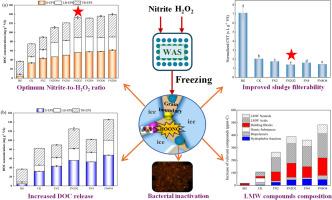亚硝酸盐和H2O2冷冻活化氧化对废液活性污泥高效增溶和过滤性能的影响
IF 12.4
1区 环境科学与生态学
Q1 ENGINEERING, ENVIRONMENTAL
引用次数: 0
摘要
亚硝酸盐预处理可有效改善废活性污泥的增溶性。在本研究中,研究了一种含有亚硝酸盐和H2O2的冷冻活化氧化方法,该方法显著提高了性能。当亚硝酸盐与h2o2的最佳摩尔比为1:1时,随着亚硝酸盐浓度从100 mg L−1增加到400 mg L−1,溶解有机碳(DOC)的释放量从38.4±0.6 mg C g−1 VS增加到67.6±0.6 mg C g−1 VS。相比之下,单独冷冻处理仅产生32.2±1.0 mg DOC g−1。假设冷冻浓度效应促进了过氧亚硝酸(HOONO)及其活性中间体的原位形成,从而大大增强了对细胞外聚合物物质和微生物细胞的破坏。这导致了低分子量(LMW)组分的大量释放,包括疏水有机物、构建块、LMW酸和中性物质,特别是LMW酸,增加了4.5倍。此外,亚硝酸盐和H2O2冷冻活化氧化可显著提高污泥的过滤性能,毛细管吸附时间缩短80%以上,中位粒径提高约7倍。值得注意的是,冻融过程的二次利用进一步促进了WAS的增溶。这些发现表明,亚硝酸盐和H2O2的冷冻活化氧化是一种有前途的策略,可以加强污泥的处理和资源回收,特别是在寒冷气候地区。本文章由计算机程序翻译,如有差异,请以英文原文为准。

Freezing-Activated Oxidation with Nitrite and H2O2 for Efficient Waste Activated Sludge Solubilization and Filterability
Nitrite-based pretreatment has been demonstrated to effectively improve waste activated sludge (WAS) solubilization. In this study, a freezing-activated oxidation method incorporating both nitrite and H2O2 was investigated, demonstrating significantly improved performance. At an optimal nitrite-to-H2O2 molar ratio of 1:1, the release of dissolved organic carbon (DOC) increased markedly from 38.4 ± 0.6 to 67.6 ± 0.6 mg C g−1 VS, as the nitrite concentration rose from 100 mg L−1 to 400 mg L−1. In contrast, the freezing alone treatment yielded only 32.2 ± 1.0 mg DOC g−1 VS. The freeze-concentration effect was hypothesized to facilitate the in-situ formation of peroxynitrous acid (HOONO) and its reactive intermediates, which substantially enhanced the disruption of extracellular polymeric substances and microbial cells. This led to a substantial release of low molecular weight (LMW) fractions, including hydrophobic organics, building blocks, LMW acids, and neutrals—particularly LMW acids, which increased by 4.5-fold. In addition, freezing-activated oxidation with nitrite and H2O2 significantly improved sludge filterability, with capillary suction time reduced by over 80% and median particle size increased by about 7-fold. Notably, secondary utilization of the freeze-thaw process further promoted WAS solubilization. These findings suggest that freezing-activated oxidation with nitrite and H2O2 represents a promising strategy for enhancing sludge treatment and resource recovery, particularly in cold climate regions.
求助全文
通过发布文献求助,成功后即可免费获取论文全文。
去求助
来源期刊

Water Research
环境科学-工程:环境
CiteScore
20.80
自引率
9.40%
发文量
1307
审稿时长
38 days
期刊介绍:
Water Research, along with its open access companion journal Water Research X, serves as a platform for publishing original research papers covering various aspects of the science and technology related to the anthropogenic water cycle, water quality, and its management worldwide. The audience targeted by the journal comprises biologists, chemical engineers, chemists, civil engineers, environmental engineers, limnologists, and microbiologists. The scope of the journal include:
•Treatment processes for water and wastewaters (municipal, agricultural, industrial, and on-site treatment), including resource recovery and residuals management;
•Urban hydrology including sewer systems, stormwater management, and green infrastructure;
•Drinking water treatment and distribution;
•Potable and non-potable water reuse;
•Sanitation, public health, and risk assessment;
•Anaerobic digestion, solid and hazardous waste management, including source characterization and the effects and control of leachates and gaseous emissions;
•Contaminants (chemical, microbial, anthropogenic particles such as nanoparticles or microplastics) and related water quality sensing, monitoring, fate, and assessment;
•Anthropogenic impacts on inland, tidal, coastal and urban waters, focusing on surface and ground waters, and point and non-point sources of pollution;
•Environmental restoration, linked to surface water, groundwater and groundwater remediation;
•Analysis of the interfaces between sediments and water, and between water and atmosphere, focusing specifically on anthropogenic impacts;
•Mathematical modelling, systems analysis, machine learning, and beneficial use of big data related to the anthropogenic water cycle;
•Socio-economic, policy, and regulations studies.
 求助内容:
求助内容: 应助结果提醒方式:
应助结果提醒方式:


